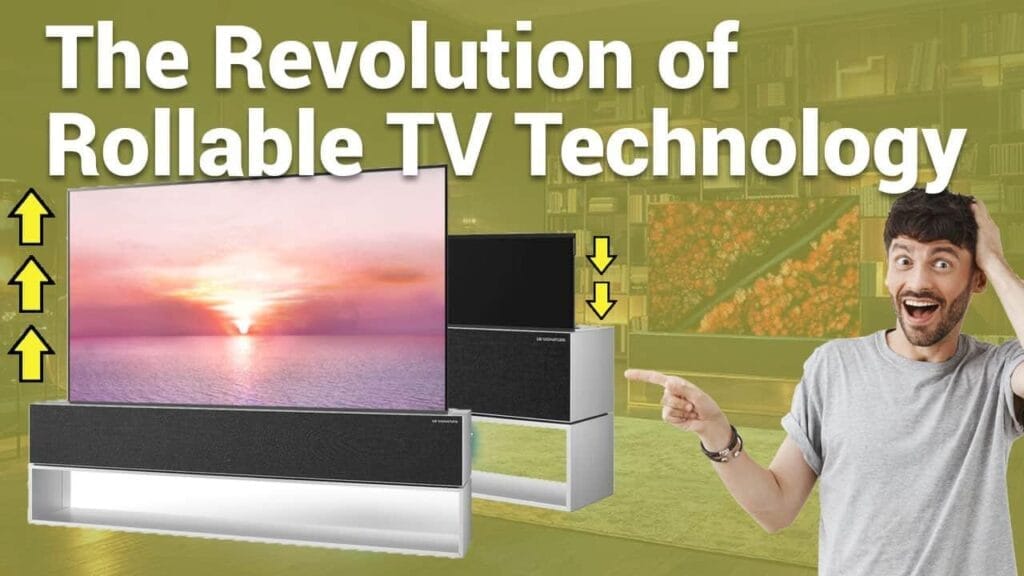
In recent years, Wireless Rollable TVs have emerged as one of the most exciting innovations in home entertainment technology. These futuristic displays are transforming how we think about televisions, combining flexibility, space efficiency, and wireless convenience. This article provides an in-depth look at Wireless Rollable TVs, how they work, and the different types available. Additionally, we’ll explore how the ONext brand contributes to this new category without focusing on advertising, but rather understanding what makes rollable TVs stand out.
What Is a Wireless Rollable TV?
A Wireless Rollable TV is a television with a flexible screen that can roll up and retract into a compact base when not in use. Unlike traditional flat-screen TVs, which are static and require significant wall or stand space, a rollable TV allows for a more adaptable use of space, making it ideal for smaller homes or people who prefer minimalist design.
These TVs use OLED (Organic Light-Emitting Diode) or similar display technology, which enables the flexibility needed for the screen to roll up. At the same time, these screens provide high-resolution visuals, rich colors, and deep contrasts. The screen’s ability to roll does not compromise the picture quality, which is on par with top-of-the-line flat screens.
Another key feature of Wireless Rollable TVs is their wireless connectivity. These televisions don’t need physical connections like traditional cable setups. Instead, they stream content using Wi-Fi or Bluetooth, making them ideal for modern smart homes. ONext, a brand in the consumer electronics space, offers models that leverage these wireless technologies for seamless, cable-free setups.
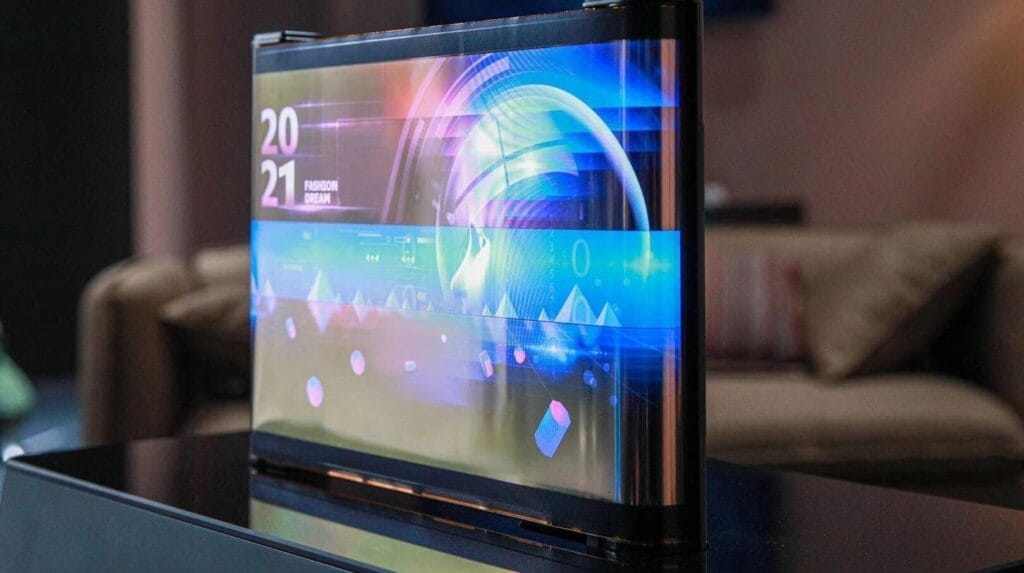
How Does a Wireless Rollable TV Work?
At the core of Wireless Rollable TV technology are flexible display panels that can be physically manipulated without damage. In most cases, the screen is made from OLED panels, which are thin, lightweight, and flexible. The TV is mounted onto a motorized mechanism housed inside a base, which controls the screen’s rolling action.
When turned on, the screen gently unrolls from the base, expanding into a full-sized display. When turned off, the screen retracts, effectively “disappearing” into the base. This process is motorized and can be controlled using a remote, smartphone app, or even voice commands through smart assistants like Amazon Alexa or Google Assistant.
Key Benefits of Wireless Rollable TVs
Here are a few reasons why rollable TVs are attracting attention:
- Space Efficiency: Their ability to roll up and retract into a small base makes them perfect for homes with limited space or minimalist design aesthetics.
- Wireless Setup: With no need for cables, these TVs are easier to install and maintain.
- Flexibility: The flexible OLED screen allows for various sizes without compromising picture quality, whether partially or fully unrolled.
- Aesthetic: When the screen is rolled up, it leaves a clean, unobtrusive base that integrates seamlessly with home decor.
What Are the Types of Wireless Rollable TVs?
As this technology is relatively new, only a few types of rollable TVs are available. However, they all share the fundamental concept of a retractable, flexible display combined with wireless capabilities. Let’s explore the main types:
1. OLED Rollable TVs
The most widely available form of rollable TV is based on OLED technology. OLED panels are constructed from organic compounds that emit light when an electric current is applied. This unique feature makes them flexible while maintaining excellent picture quality.
Key Characteristics of OLED Rollable TVs:
- Flexible and Thin: OLED screens are highly flexible, allowing them to roll up and retract without affecting the integrity of the display.
- Vibrant Display Quality: OLED technology provides a superior picture with deep blacks, vibrant colors, and excellent contrast.
- Durable: OLED screens are durable enough to withstand thousands of roll and unroll cycles, making them ideal for daily use.
OLED rollable TVs are currently the most common type, with companies like LG being pioneers in this space. ONext has also explored the potential of using OLED for their rollable screens, particularly due to its flexibility and the high-quality viewing experience it offers.
2. MicroLED Rollable TVs
MicroLED technology is another option being developed for rollable TVs. MicroLED screens use tiny LED modules to produce images, offering several advantages over OLED, including higher brightness levels and longer life spans. However, these displays are still mostly in the prototype phase.
Key Characteristics of MicroLED Rollable TVs:
- Higher Brightness: MicroLEDs can achieve much brighter displays compared to OLED.
- Longevity: MicroLEDs are not as prone to image burn-in, making them more durable for long-term use.
- Still Developing: While promising, MicroLED rollable TVs are not yet widely available, though several companies are actively working on bringing them to market.
As rollable TVs continue to evolve, MicroLED technology could offer a more durable alternative to OLED, especially for those who want the benefits of flexibility without concerns about long-term performance. ONext has also been exploring the potential of integrating MicroLED into future models.

3. Concept and Prototype Rollable TVs
Various companies are experimenting with new and innovative designs for rollable TVs, some of which are still in the concept phase. For instance, some designs feature transparent displays or rolling mechanisms that deploy from unconventional locations like the ceiling or furniture.
Key Characteristics of Concept Rollable TVs:
- New Materials: Different materials such as plastic-based displays or hybrid screens are being used to make the rollable feature more resilient.
- Unique Form Factors: Some concept designs focus on rolling screens from different directions (e.g., vertically or horizontally).
- Experimental: While many of these concepts are not yet available for consumers, they showcase the exciting potential of rollable technology.
These models represent what the future of rollable TV technology could look like, providing more options and personalization for users based on their space and lifestyle.

Space-Saving Design: The Key Selling Point
One of the primary reasons consumers are drawn to Wireless Rollable TVs is the space-saving design. In homes where every inch of space matters, a rollable TV offers an elegant solution by tucking away into a small base unit when not in use. This design caters to modern, minimalist aesthetics, providing a clean, unobtrusive look in any room.
Perfect for Minimalist and Small Spaces
The roll-up design makes Wireless Rollable TVs especially appealing to people living in small apartments or homes where space is at a premium. Instead of dedicating an entire wall or bulky furniture to a large flat-screen TV, users can simply roll the TV out when needed and hide it away when not in use. This feature is ideal for open-concept living areas or rooms with limited wall space.
For those who prefer even smaller, more compact screens, ONext’s 21.5 to 32-inch models provide an excellent solution. These wireless smart screens offer the same wireless flexibility in a size range that can be easily moved or stored, making them perfect for tight spaces or as secondary entertainment systems.
Innovative Technology Behind Wireless Rollable TVs
The technologies enabling Wireless Rollable TVs are cutting-edge, combining flexible OLED panels with motorized mechanisms and wireless connectivity. Here’s a deeper dive into how these technologies work:
1. Flexible OLED Technology
OLED screens are made from organic materials that emit light when an electrical current is passed through them. Unlike LED or LCD displays, OLED does not require a backlight, allowing the screen to be thinner, lighter, and more flexible. This makes it perfect for rollable TVs, as the screen can bend and roll without damaging the pixels.
The display quality of OLED is unmatched, offering superior contrast ratios, deeper blacks, and more vibrant colors compared to traditional screens.
2. Motorized Rolling Mechanism
Rollable TVs are built with precision motorized systems that allow the screen to roll up or down smoothly. The motor is housed within the base unit, and it’s designed to ensure that the screen retracts without creases or damage. Users can control this process through a remote, smartphone app, or even via voice commands if integrated into a smart home system.
3. Wireless Connectivity
Another key feature of rollable TVs is the wireless capability. These TVs connect to the internet and other devices via Wi-Fi or Bluetooth, eliminating the need for messy cables. This wireless design enhances the minimalist aesthetic, making rollable TVs ideal for smart homes.
Brands like ONext offer wireless smart screens in their 21.5 to 32-inch range, which can connect seamlessly to streaming services, gaming consoles, and other smart devices without the need for traditional cables.
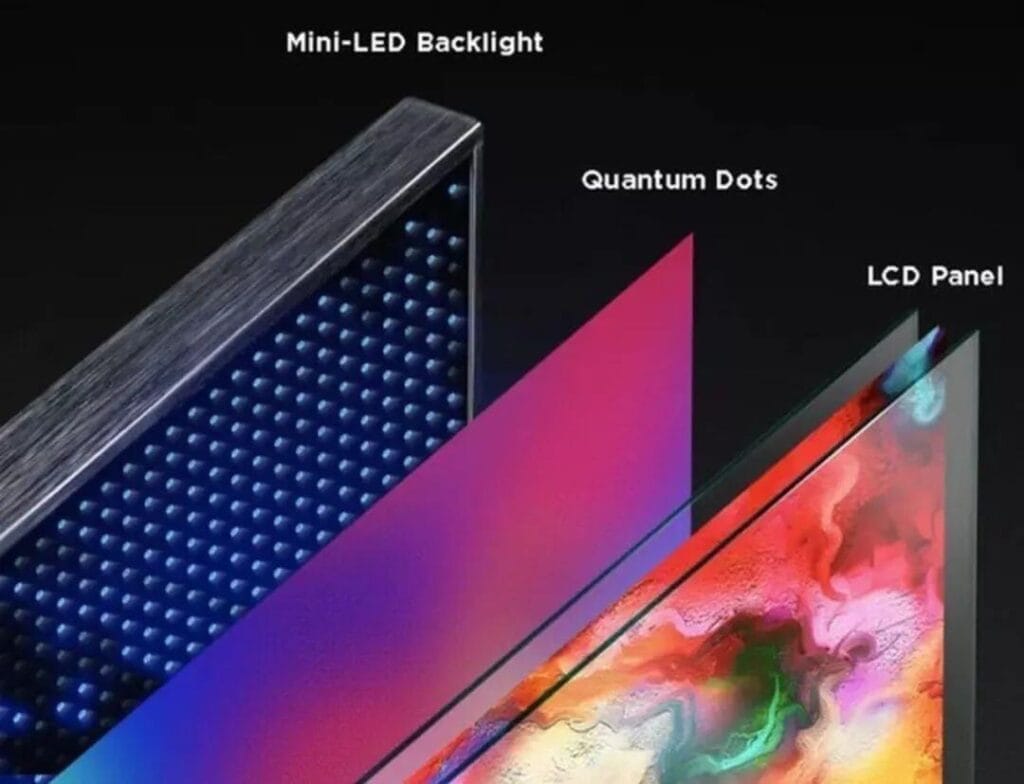
Durability and Lifespan of Rollable TVs
Durability is a common concern with any new technology, and rollable TVs are no exception. However, manufacturers have worked hard to ensure that these flexible screens can withstand frequent use.
Rigorous Testing for Longevity
Most rollable TVs are designed to endure thousands of roll and unroll cycles. These devices undergo extensive testing in labs to simulate years of daily use, ensuring that the motorized components and the OLED screen can handle long-term wear and tear.
Additionally, materials used in the screen, like high-strength plastics and specialized coatings, ensure that the display remains durable despite its flexible nature.
Future Trends in Rollable TV Technology
As rollable TVs grow in popularity, we can expect several future trends to emerge, both in terms of technology and design.
1. More Affordable Options
Currently, rollable TVs are premium products with a high price tag. However, as the technology matures and manufacturing becomes more cost-effective, prices will likely drop. This will make rollable TVs accessible to a wider audience.
2. Integration with Smart Home Systems
We’re also likely to see further integration with smart home systems, allowing rollable TVs to act as central hubs for controlling lighting, security, and other home devices. With voice commands becoming more prevalent in everyday technology, you’ll be able to control not only your TV but also other smart appliances with a single voice request.
3. Modular and Customizable Designs
As rollable TV technology advances, we may see more modular designs that allow for customization based on user preferences. For example, consumers might be able to choose from various base unit styles or select different materials and colors to better match their home decor. There’s also potential for more modular TV setups, where screens can be rolled out from walls or ceilings, giving users more flexibility in how they position their entertainment systems.
Concept designs are already hinting at these possibilities, and companies like ONext could be at the forefront of offering customizable, modular wireless smart screens. Their compact models, especially in the 21.5 to 32-inch range, offer flexibility in positioning and use, making them great for multi-purpose rooms or non-traditional setups like kitchens or bathrooms.
4. Enhanced Durability and Longer Lifespan
While OLED technology is already known for its exceptional picture quality, future improvements may further increase the lifespan and durability of rollable TVs. As manufacturers refine the flexible materials used in these screens, we can expect more robust designs that can handle even more frequent rolling and unrolling without degradation in picture quality.
Additionally, advances in MicroLED technology might offer an alternative to OLED, delivering even longer-lasting displays with improved brightness and energy efficiency. Once MicroLED becomes more widely available, brands like ONext may incorporate this technology into their wireless screen offerings, giving users even more options for their home entertainment needs.
Why Choose ONext Wireless Smart Screens?
If you’re not quite ready to invest in a full-sized rollable TV, ONext’s wireless smart screens offer a perfect alternative. Designed with compact living spaces in mind, their 21.5 to 32-inch models provide excellent picture quality, wireless connectivity, and seamless integration with other smart home devices.
Key Features of ONext Wireless Smart Screens:
- Portability: Smaller screens are easy to move and can be placed in various rooms, making them perfect for kitchens, offices, or even outdoor spaces.
- Wireless Functionality: Just like rollable TVs, ONext’s models eliminate the need for clunky cables, providing a clean, organized setup.
- Smart Home Integration: These screens are designed to work with popular smart home systems like Amazon Alexa and Google Assistant, allowing you to control your entertainment setup with simple voice commands.
- Cost-Effective: ONext offers these smaller wireless screens at a fraction of the cost of full-sized rollable TVs, making it an affordable option for those who want cutting-edge technology without breaking the bank.
By offering these versatile smart screens, ONext provides a solution for users who want flexibility and convenience without the need for a larger, more expensive rollable TV.
Best Uses for ONext’s 21.5-32 Inch Wireless Smart Screens
- Bedrooms and Guest Rooms: These compact models are perfect for secondary viewing spaces where a large rollable TV might not be necessary.
- Kitchens: Ideal for watching shows or following along with recipes while cooking.
- Home Offices: The compact size makes ONext screens perfect for video conferencing or streaming music during work.
- Outdoor or Patio Spaces: Easily portable, these screens can be set up for movie nights or outdoor events.
-
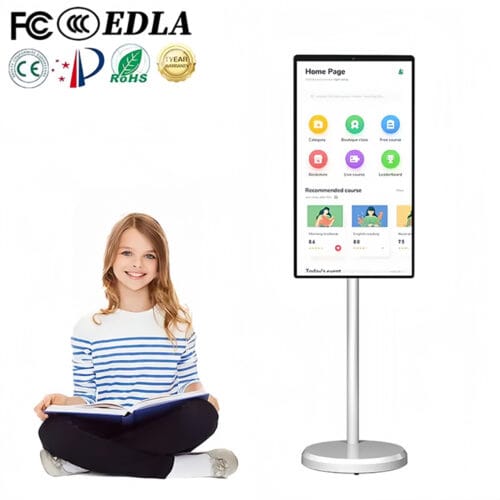 24 inch Stand By Me TV Movable Touch Television
24 inch Stand By Me TV Movable Touch Television -
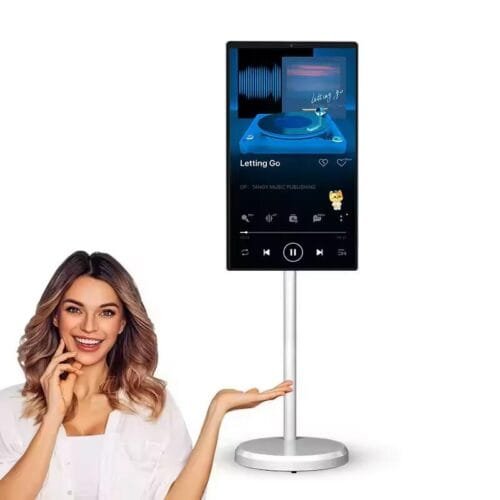 27-Inch Portable Tv Monitor On Wheels Touch Screen 1080p 64GB Storage Smart Screen,Portable Monitor Rotating Display With Mobile Base,With Built-in Battery ,Smart Monitor with Type-C Port
27-Inch Portable Tv Monitor On Wheels Touch Screen 1080p 64GB Storage Smart Screen,Portable Monitor Rotating Display With Mobile Base,With Built-in Battery ,Smart Monitor with Type-C Port -
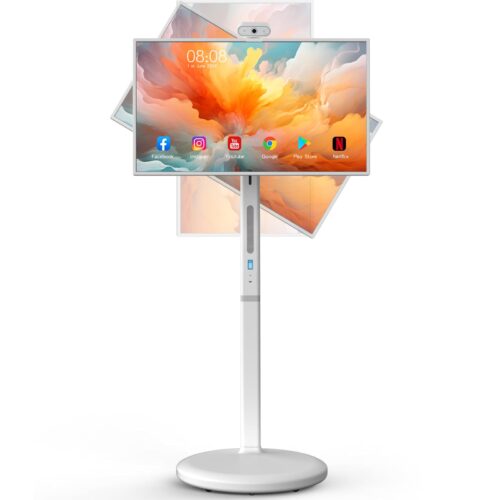 Portable Smart TV 32″ 1080P Touch Screen Monitor on Wheels, Android OS 13 Built-in Battery, Detachable Camera and Stand, Full Swivel Rotation Rolling Tablet for Kitchen, Bedroom, Outdoors
Portable Smart TV 32″ 1080P Touch Screen Monitor on Wheels, Android OS 13 Built-in Battery, Detachable Camera and Stand, Full Swivel Rotation Rolling Tablet for Kitchen, Bedroom, Outdoors -
 Stand by Me TV 21.5-Inch 1080P Portable TV on Wheels Touch Screen Monitor, Built in Battery, Full Swivel Rotation, Android12, 60Hz Refresh Rate
Stand by Me TV 21.5-Inch 1080P Portable TV on Wheels Touch Screen Monitor, Built in Battery, Full Swivel Rotation, Android12, 60Hz Refresh Rate
Conclusion: The Future of Television and ONext’s Role
Wireless Rollable TVs represent the next generation of home entertainment technology, combining sleek, space-saving designs with high-end display quality. While the technology is still evolving and comes at a premium price, it’s clear that rollable TVs will become more mainstream as production costs decrease and more models become available.
ONext, with its range of wireless smart screens, is already addressing the needs of consumers who want flexibility, portability, and wireless convenience without the investment required for a full-sized rollable TV. Their 21.5 to 32-inch models offer an affordable, high-quality alternative for those looking to enhance their home entertainment experience in a more compact form.
As the future of display technology continues to unfold, we can expect more customization options, improved smart home integration, and even more durable screens. Whether you’re investing in the latest rollable TVs or opting for a more compact wireless screen like those from ONext, one thing is certain: the future of TV is wireless, flexible, and designed for modern living.